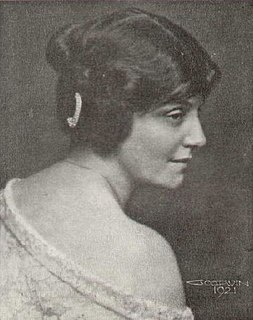Related Research Articles

Johanne Luise Heiberg was a Danish actress of the 19th century. She is most famous for her work at the Royal Theatre in Copenhagen, where she achieved great success. Though she was closely connected to the romantic tradition, Heiberg is still regarded as a key figure of Danish drama. She contributed to the growing public social and moral perception of Danish actors as artists and cultural personalities rather than simply performers.

Caroline Frederikke Müller née Halle also known as Caroline Walther, was a Danish and later naturalized Swedish opera singer (mezzo-soprano). She was also active as an instructor at the Dramatens elevskola. She was a member of the Royal Swedish Academy of Music and a Hovsångare.

Mette Marie Astrup was a Danish actress, one of the best known of her time in Denmark. She enjoyed a career totaling fifty years at the Royal Danish Theatre in Copenhagen.

Caroline Amalie Thielo was a Danish actress, one of her country's first professional native female actors, and said to be the first actress ever employed at the Royal Danish Theatre in Copenhagen. She was very popular in the mid 18th century, and was also employed as a translator of plays for the theatre.
Emilie da Fonseca, married surnames Muller and Bratz was a Norwegian-Danish stage actor and opera singer. She belonged to the pioneer group of artists in the first national theatre in Norway. She was also among the most noted artists of her time in Norway.

Amalia Emma Sophie Hartmann née Zinn was a Danish composer who composed under the pseudonym Frederik H. Palmer. She was married to the composer Johan Peter Emilius Hartmann (1805–1900). They lived on the second floor in the Zinn House at Kvæsthusgade 3 in Copenhagen.

Anna Helena Dorothea Nielsen, née Brenöe,, was a Danish stage actress and opera singer (mezzo-soprano). She was one of the most famous female stage artists in Denmark of her time. She was a mentor for many talents, such as for example Louise Phister and her private home was a center of the theatre world.

Emilie Wilhelmine Rosing was a Danish singer and stage actress. She was perhaps the most famous female stage artist in Denmark during the age of Napoleon.

Johanne Cathrine Rosing, née Olsen, was a Danish stage actress and ballet dancer, one of the most noted of the era.
Eline Heger, née Schmidt, was a Danish stage actress.

Birgitte Elisabeth Andersen was a Danish stage actor and ballet dancer.
Maria Theresia Ahlefeldt was a Danish,, composer. She is known as the first female composer in Denmark.

Nini Arlette Theilade was a Danish ballet dancer, choreographer and teacher.
Josephine Amalie Zinck née Lund (1829–1919) was a Danish mezzo-soprano singer who performed in concerts at Copenhagen's Musikforeningen from the age of 18 and in operas at the Royal Danish Theatre from 1858.

Sophie Helene Henriette Keller née Rung (1850–1929) was a Danish operatic soprano, musician and singing teacher, who performed at the Royal Danish Theatre in Copenhagen from 1869. She founded both a conservatory for women and a women's concert association.

Marie Cathrine Preisler née Devegge (1761–1797), was a Danish stage actress.
Cathrine Marie Gielstrup née Morell (1755–1792) was a Danish stage actress. She was active at the Royal Danish Theatre in 1773–1792, and a member of the Det Dramatiske Selskab in 1777-79.

Michael Rosing was a Norwegian-Danish actor.
Marie Elisabeth Zinck née Thomsen (1789–1823) was a Danish actress and operatic soprano. After initially training at the Royal Danish Ballet school, she made her début at the Royal Danish Theatre as an actress in 1808. Thanks to her pleasant voice, she increasingly performed in plays with musical roles or in operas and operettas, becoming a firm favourite with her audiences. One of her most successful roles was that of Cherubin in The Marriage of Figaro, both in the play by Pierre Beaumarchais and in Mozart's opera. She performed in a wide variety of productions until her death from pneumonia in early 1823, just 33 years old.

Birgitte Sigrid Frieda Engell née Engel (1882–1973) was a German-born Danish operatic soprano who initially performed in operas in Wiesbaden and Berlin before moving to the Royal Danish Opera in Copenhagen. After the First World War she increasingly specialized in concerts, giving recitals in several European countries and North America until the early 1930s. In later life she settled in Copenhagen where she taught voice.